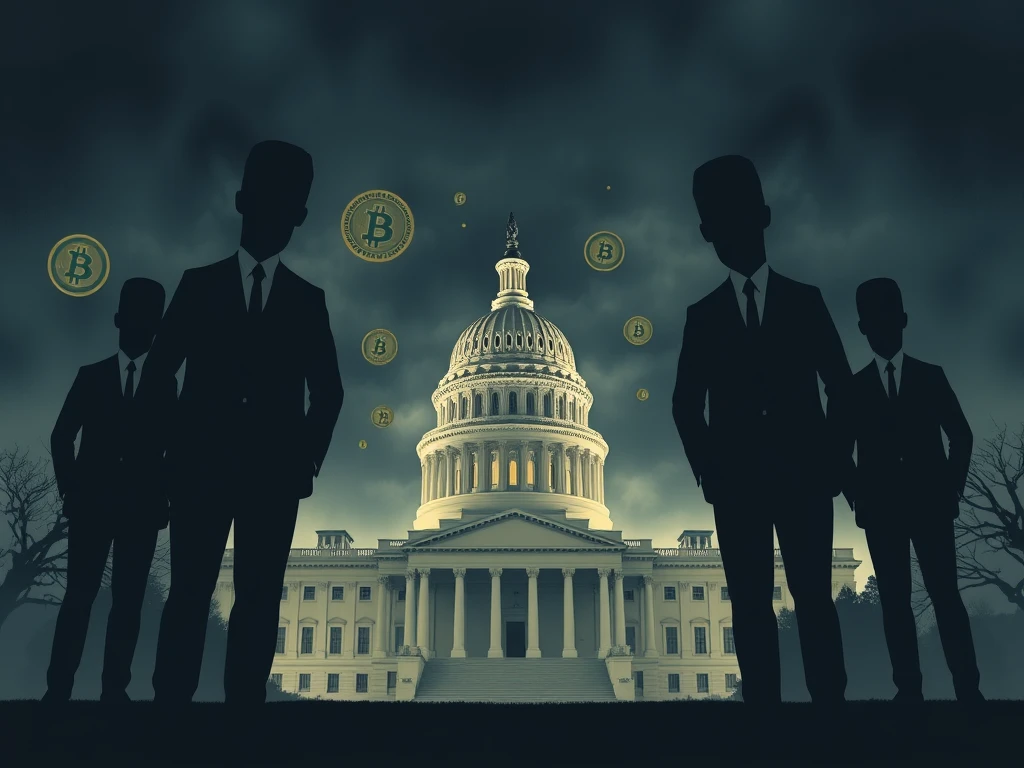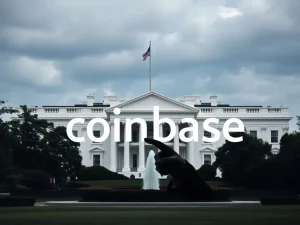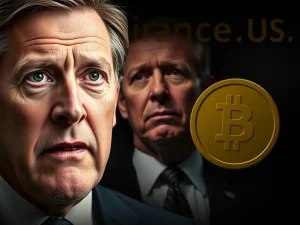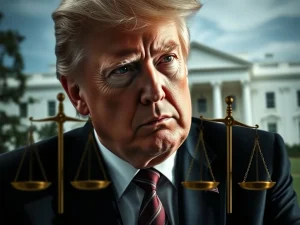Exposed: The Urgent Crypto Regulatory Capture Problem in Washington?

Is the burgeoning crypto industry in danger of being swayed by undue influence in the halls of power? Whispers of regulatory capture are growing louder in Washington D.C., sparking debates among lawmakers, industry insiders, and even crypto enthusiasts. The question isn’t just about whether large crypto firms are having their voices heard—it’s about whether those voices are drowning out the public interest and potentially stifling competition within the crypto space itself. Let’s dive deep into the heart of this pressing issue and explore the complexities of crypto regulation in the nation’s capital.
Decoding Regulatory Capture in the Crypto Arena
What exactly is regulatory capture, and why is it a concern for the crypto world? In essence, it’s a situation where regulatory bodies or lawmakers become overly influenced by the very industries they are meant to oversee. This can lead to policies that primarily benefit a select few – often large, established players – rather than serving the broader public or fostering a level playing field. The dangers of regulatory capture are twofold:
- Public Interest Neglected: Policy decisions may be skewed to favor a specific industry or company, sidelining the needs and interests of the general public.
- Economic Risks Ignored: Regulators might become blind to or paralyzed by potential economic risks, as their judgment is clouded by the influence of the captured industry.
The fear is that as crypto lobbying efforts intensify in Washington, the industry may inadvertently create an environment ripe for regulatory capture. This isn’t just a theoretical concern; lawmakers and industry observers are actively voicing worries about its potential impact on the future of crypto in America.
Crypto Lobbying: Amplifying Voices in Washington
The crypto industry’s growing presence in Washington is undeniable. With significant financial resources and sophisticated lobbying strategies, crypto firms are making sure their perspectives are heard on Capitol Hill. This increased visibility has undoubtedly raised the chances of legislation favorable to the industry. However, it simultaneously fuels concerns about whether this influence is becoming disproportionate. Is crypto regulation being shaped by genuine public interest or by the strategic maneuvering of well-funded crypto giants?
Consider the recent letter from prominent members of the US Senate Banking Committee and Committee on Finance. Their communication to Acting Comptroller Rodney Hood and Michelle Bowman, Chair of the Federal Reserve Board of Governor’s Committee on Supervision and Regulation, specifically addressed World Liberty Financial (WLFI), a decentralized finance project linked to the Trump family, and their stablecoin project, USD1. This came as Congress deliberates the GENIUS Act, legislation focused on stablecoins. The senators highlighted potential conflicts of interest, pointing out that former President Trump’s involvement could lead to undue influence over regulatory decisions regarding USD1 and its competitors. This situation underscores the delicate balance between legitimate industry advocacy and potential regulatory capture.
Stablecoin Policies: A Battleground for Regulatory Influence?
The debate around stablecoin regulation provides a stark example of the regulatory capture concerns within the crypto space. Coinbase, a major player in the crypto exchange arena, and their stance on stablecoin legislation has drawn considerable scrutiny. CEO Brian Armstrong indicated a willingness to delist Tether (USDT), the dominant stablecoin, if a particular version of the stablecoin bill became law. This version, critics argue, could disproportionately benefit USDC, in which Coinbase holds a significant stake, by effectively excluding its largest competitor, USDT, from the US market.
Nic Carter, a partner at Castle Island Ventures, didn’t mince words, labeling this situation as “regulatory capture” and drawing parallels to past actions of Sam Bankman-Fried (SBF). Vance Spencer of Framework Ventures echoed this sentiment, calling it a “blatant attempt at regulatory capture by US players” that could harm US national interests. These voices highlight the fear that crypto regulation, particularly concerning stablecoins, might be manipulated to favor specific entities at the expense of competition and broader market health.
George Selgin, a senior fellow at the Cato Institute, points to another instance of perceived crypto lobby influence – the Bitcoin reserve initiative. He suggests that the idea of the US government maintaining digital asset stashes might not have gained traction without “intense pressure from cryptocurrency enthusiasts.” These examples raise critical questions about the extent to which crypto regulation is being shaped by genuine policy needs versus industry lobbying.
Regulatory Capture: An Old Washington Story, New Players
It’s crucial to acknowledge that lobbying and industry influence are not novel phenomena in Washington. “Regulatory capture,” in many ways, might seem like standard operating procedure in the world of policymaking. Various industries have long sought to shape regulations to their advantage. Selgin astutely points out that the Biden administration’s earlier approach to crypto, perceived as more hostile, was also a form of regulatory capture, albeit favoring traditional financial firms seeking to limit competition from crypto upstarts. The landscape of regulatory capture in Washington isn’t new; what’s changing is the cast of characters vying for influence. The crypto industry is now stepping into this established arena, learning to navigate the complexities of Washington’s power dynamics.
Advocacy vs. Capture: Where is the Line?
Disentangling legitimate industry advocacy from regulatory capture can be a nuanced task. As Selgin notes, “the line between them is very thin.” Industries inherently advocate for their interests, and this advocacy often shapes regulatory outcomes to some degree. Successful advocacy, by its very nature, influences regulators’ perspectives and approaches. The key question isn’t whether the crypto industry is influencing crypto regulation – it’s about whether that influence leads to regulations that ultimately serve the public good.
Furthermore, the crypto industry itself is not monolithic. Different firms within the crypto ecosystem often have divergent views on ideal regulations. This internal diversity can act as a natural check against complete regulatory capture by any single entity or interest group. The dynamic interplay of competing interests within the crypto space, alongside public scrutiny and regulatory oversight, shapes the evolving landscape of crypto regulation in Washington.
Seeking Solutions: Navigating the Path Forward for Crypto Regulation
If regulatory capture is an inherent risk in policymaking, what can be done? Some academics have proposed radical solutions, such as creating entirely new government bodies to monitor regulator behavior. Gerard Caprio, an economics professor emeritus at Williams College, suggested an expert panel, a “Sentinel,” to oversee regulators. However, such proposals face significant hurdles. The technical complexities are immense, and perhaps more importantly, lawmakers may lack the incentive to establish bodies that would scrutinize their own actions and influence.
Ultimately, Selgin argues, the focus should not solely be on preventing industry influence. Instead, the critical question is “whether the resulting regulatory regime serves the public interest.” Harmful regulations are detrimental regardless of their origin. The challenge for crypto regulation is to ensure that the rules crafted in Washington are not just products of industry lobbying but are genuinely designed to foster innovation, protect consumers, and promote a healthy and competitive crypto ecosystem.
Public Trust and the Future of Crypto Regulation
The public’s perception of crypto and crypto regulation plays a crucial role in shaping the political landscape. Public sentiment towards crypto is complex and often divided. Polls on crypto ownership, trust, and sentiment vary widely. The Trump administration’s embrace of crypto, while welcomed by some in the industry, has also alienated skeptics and moderate voters. This mixed public reception adds another layer of complexity to the crypto regulation debate in Washington.
Even crypto lobbyists acknowledge that the bipartisan push for crypto legislation is partly driven by political calculations. Ahead of the 2026 midterms, there’s a recognition that the crypto industry’s financial contributions and the growing base of crypto users are factors that lawmakers are considering. Dave Grimaldi of the Blockchain Association highlights the electoral impact of pro-crypto candidates and the consequences faced by those perceived as anti-crypto. This political dimension underscores that crypto regulation is not just about policy details; it’s also intertwined with electoral dynamics and political strategy.
Conclusion: Balancing Influence and Public Interest in Crypto Regulation
The specter of regulatory capture looms large over the evolving landscape of crypto regulation in Washington. While industry advocacy is a legitimate part of the political process, the potential for undue influence raises critical questions about fairness, competition, and the public interest. Navigating this complex terrain requires a commitment from lawmakers and regulators to prioritize the broader public good, foster open dialogue, and resist the allure of regulatory capture. The future of crypto innovation and its integration into the financial system hinges on striking the right balance – ensuring that crypto regulation is both informed by industry expertise and firmly rooted in the principles of public service and equitable market practices.








